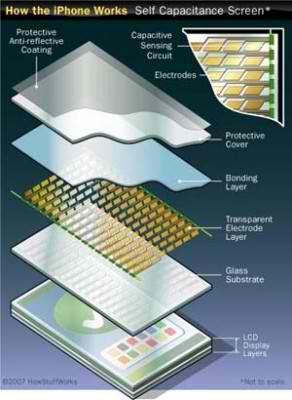many smart phones that use touch-screen instead of keypad input. Besides a unique and interesting, it turns out the touch screen will save some unnecessary areas.
One of the best mobile phone with touch screen is Apple's iPhone product. They called multitouch features that make it easy to control. But do you know how the screen can translate physical inputs which were charged to him?
In general, the touch screen has three main components which touch sensors, controllers and software drivers. Touch screen as input device must be combined with the screen to be recognized as a mechanism for input by touch.
Touch sensor is a clear glass panel with a surface which is responsive to the touch. Sensors placed on the display panel so that the responses cover the entire surface area on the display screen. There are several methods of applying touch-screen technology on the market now, each of which differ on how to detect touch input. But in general the use of touch as electricity or the signal changes. Changes in voltage is also used to distinguish the location of touch on the screen.
Controller is a device that connects between the sensor and central processing (CPU). Information provided from the touch and then translated by the data processing center. Controller is generally installed under the screen or placed in a plastic container. Had a touch screen integrated with the extra cable from the touch screen behind earlier. Special controller have been there previously on DVD players and other devices.
While the 'driver' is a software or software with touch-screen system that allows this work together with the processing center. Then it was translated and sent to the controller. This technology is similar to how it works drivers 'mouse' on a PC / computer. So touch the screen will be translated as do click on the 'mouse'.
How To Know Where You Touch Screen Touch
There are three basic systems used to identify someone that is resistive touch (which is inhibited), capacitive (retentive) and surface acoustic wave (surface acoustic wave)
1. Resistive system. This system consists of ordinary glass panels covered with conductor and a resistive metallic layer. Both layers are separated by 'spacer', and scratch resistant coating that is placed on the top surface. Electric current will flow through these two layers occurs when the monitoring process. When a user touches the screen, the two layers make connections at that point. Electrical changes will be recorded and dikoordinatkan as a point of contact and calculated by the processor. When the coordinates are known, a driver can translate into something understandable by the processor or operating system used.
2. Capacitive system. This system consists of layers of deposits containing electric charges placed on a glass panel display. When a user touches the screen with a finger, some electric charge transferred to the user so that the load on the capacitive layer decreases. This decrease is measured by an electronic circuit on each corner of the screen. One advantage of this system capasitive that he transmits almost 90 percent of the light there on the screen. So the resistive system only transmits about 75 percent. This makes the capacitive system produces a clearer image than the resistive system.
3. Surface acoustic wave system. This system puts two pieces 'transducers' (one sender and one receiver) is placed at position x and y axis of the screen. On display was also placed 'Reflectors' which reflects the signal transmission from one transducer to another transducer. Receiving transducer is able to explain when the collision occurred when a touch occurs and explain the position of the collisions occurred.
Settings with this wave has no metallic layers on the screen, allowing delivery of light and generate 100 percent perfect image clarity. This makes the system 'surface acoustic wave' to be the best system for displaying detailed images.
Different regions will be identified as areas that are untouched. Systems 'resistive' will recognize the touch along the two layers of contact / relationship, which means it does not matter if you press the screen with your finger or stylus if the rubber. Systems 'capacitive' must use the input that is brought, that is so recognizable as your fingers touch. While the system of 'surface acoustic wave' like the resistive system that allows you to touch using a variety of objects. So far, the system of 'resistive' is a system with the cheapest cost in the process of manufacture, but the most easily damaged when using sharp objects when touching it.
IPhone Multi Touch System
iPhone uses a new mechanism of inerface touch technology that existed previously. They called multitouch.
Screen touch-sensitive screen covered with a layer of material 'capasitive'. However the capacitor on the iPhone phone is set to a coordinate system. Circuit that can sense changes made from every point on all the existing grid. In other words, every point on the grid is set in such a way that has own signal when touched and connect the signal to the processor.
This makes the mobile phone can distinguish the location and movement of the touch continuously performed on multiple locations. Because the material relied on 'capasitive' this, phone the iPhone only work with the touch of your fingertips. That means will not work if you use the stylus or using anti penghantar gloves (non-conductive).





No comments:
Post a Comment